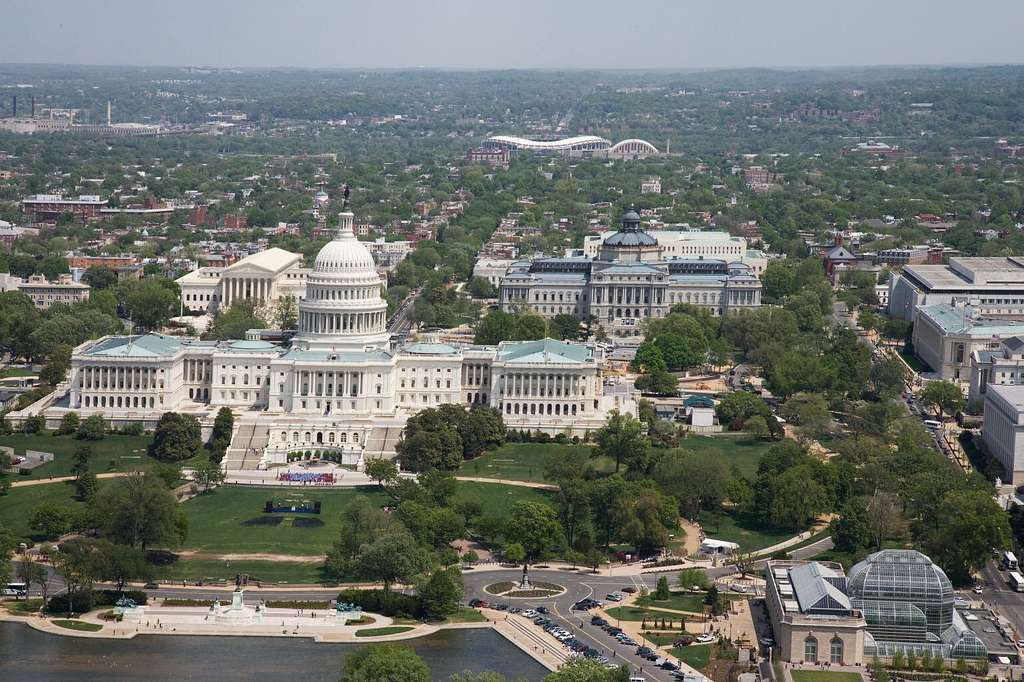Negotiations over increasing the federal debt ceiling continue in Washington. As has occurred several times over the past twenty years, Republicans and Democrats are presently using increases in the debt ceiling as a bargaining chip in negotiating how federal tax dollars will be spent.
Most of this is theater. We know how these negotiations always end: the debt ceiling is always increased, massive amounts of new federal debt are incurred, and federal spending continues its upward spiral. In fact, since the last time we endured a major debate over the debt ceiling—back in 2013—the national debt has nearly doubled, soaring from $16.7 trillion ten years ago to $32 trillion in 2023. Over that same period, federal spending has increased more than 80 percent from $3.4 trillion in fiscal year 2013 to $6.2 trillion in fiscal year 2022.
So here we are again with policymakers essentially discussing how long it will take for the national debt and federal budget to double again. As far as Washington is concerned, that’s all fine. The debt ceiling will rise sizably. We know this because what really matters—as far as DC policymakers are concerned—is that the taxpayer gravy train never stops. Equally important is that the federal government not default on any of its massive debt to ensure continued access to cheap debt—and thus massive amounts of deficit spending—now and forever.
To take this narrative at face value, however, we have to buy into some big myths that policymakers are quite enthusiastic about repeating. These lies persist because the regime needs to convince the voters and the taxpayers that no matter what happens, no major changes to the tax-and-spend status quo can ever be allowed to occur. Let’s look at three of those myths now.
One: The Republicans Want Austerity
In Washington, when politicians use the word “cut,” they usually are talking about small reductions in the rate of increase in spending. For example, if Pentagon spending has been increasing at 2 percent per year (which has indeed been the average for the past decade) then an increase next year of 1.5 percent will be denounced by some as a “cut.” In reality, it’s not a cut at all, of course. Spending has increased. But in the minds of Washington policymakers, taxpayer money is rightfully theirs, so any slowdown in the flow of free money is branded a “cut.”
That’s the basic premise of what we’re seeing now when advocates of limitless increases of the debt ceiling bemoan “cuts” to Social Security or any other welfare program. In the current debate, the Republicans say they want “less spending than last year” for the 2023 fiscal year, and then a “cap” on spending at 1 percent increases in each year for the next ten years.
But before anyone claims that this is indeed some sort of meaningful “cut” let’s look at the federal outlays over the past twenty years (the 2023 FY total is CBO’s forecast):
After some moderation in spending during the second Obama term, spending again accelerated during the Trump years as then surged to new off-the-charts highs as Trump doubled down on massive spending increases during the COVID panic. Naturally, this surge continued during the Biden years, and spending now remains well above trend. Indeed, to bring spending back to the pre-2019 trend would require massive budget cuts totaling more than a trillion dollars to the annual budget
That’s certainly not in the cards right now. Rather, the Republicans are seeking a tiny reduction in spending from the CBO 2023 estimate of $6.4 trillion down to slightly below 2022’s spending of $6.27 trillion. Even with this slowdown, there is no danger of the 5-year moving average falling below where it was in 2022.
According to the GOP plan, after the proposed miniscule reduction for 2023, it’s back to annual increases of one percent. But, it’s important to remember that this “cap” on annual increases to one percent is in no way binding on future Congresses. Congress can—and will, if history is any guide—forget about any previous agreement and increase spending to meet perceived “needs” at any time.
Rather, the “cuts” we keep hearing about—even if the GOP is successful—are likely to look like the so-called “sequestration” we kept hearing about back in 2013. That was supposed to usher in an age of austerity. Instead, federal spending and debt has nearly doubled in the decade since.
In other words, any claim that Republicans want to cut spending is true in only the most narrow short-term sense. Spending remains and will likely continue to remain, far above even Trump’s huge (at the time) 2019 budget increases. The post-COVID mega-spending isn’t going away.
Two: The U.S. Has Never Defaulted
Central to the debt-ceiling and budget debate is the often-repeated claim that negotiations must be concluded immediately to ensure that the U.S. does not miss payments on any of its debts. After all, we are told, the U.S. has never missed a payment.
This is an out-and-out lie. The U.S. has absolutely, indisputably defaulted before. This began in in the wake of the American Revolution when the U.S. defaulted on domestic loans. After the new constitution was in place in 1790, the federal government renegotiated past debt at less favorable terms for investors. That’s a default.
Then there was the Greenback default of 1862. The original greenbacks were $60 million in demand notes which were redeemable in specie. Less than five months later, in January of 1862, the U.S. Treasury defaulted on these notes by failing to redeem them on demand.
Perhaps the most egregious case was the Liberty Bond default of 1934. The U.S. was contractually obligated to pay back its debts on these bonds in gold. Franklin Roosevelt decided to default on the whole of the domestically-held debt by refusing to redeem in gold to Americans and devaluing the dollar by 40 percent against foreign exchange. The U.S. refused to make good on its end of these bond contracts. That was also a default.
Then there was the short default of 1979. As Jason Zweig noted in 2011:
In April and May 1979, amid computer malfunctions, heavy demand from small investors and in the wake of Congressional debate over raising the debt ceiling, the U.S. failed to make timely payments on some $122 million in Treasury bills. The Treasury characterized the problem as a delay rather than as a default. While the error affected only a fraction of 1% of the U.S. debt, short-term interest rates—then around 9%—jumped 0.6 percentage point and the U.S. was promptly sued by bondholders for breach of contract.
So, the next Time Joe Biden or Janet Yellen go on television to insist the U.S. has never defaulted, know that you are being lied to.
Three: Default Is the End of the World
Any talk of default is sure to bring predictions of economic devastation. Those who have lived through a financial crisis or two will know how this works. As soon as signs of trouble in the economy appear, the regime lines up “experts” to tell us that unless the government is empowered to spend endlessly on bailouts and “stimulus,” then the economy will collapse, unemployment will surge, and hell on earth will ensue.
The taxpayers certainly heard this repeatedly in 2008 and 2009 as the regime insisted it must be free to hand over trillions of dollars in bailout funds to wealthy bankers and auto makers and financiers. We were told that the central bank must be able to print up trillions of dollars so as to buy up government bonds and mortgage backed securities to pad the balance sheets of the investor class. We were told this would “fix” the economy.
Naturally, when the recession turned out to be the worst since 1982, the “experts” then said—without any evidence whatsoever—that things “would have been worse” without all their bailouts.
We’re hearing the same thing now about possible default on the $32-trillion national debt. “Give us new debt ceiling increases with no strings attached” appears to be the constant refrain. Without this carte blanche, we are told, there will be economic catastrophe.
But it is all the same scare tactics the regime trots out every time it wants a new series of bailouts or immense amount of new spending. Trump hysterically said the same thing when he demanded passage of his $2.2 trillion covid “rescue plan.” We’re told there is no alternative, and any opposition is “reckless.” Rather, we must approve any and all new spending now and deal with the consequences later. But “later” never comes because the strategy is always to just kick the can further down the road. To not do so, the experts insist, will destroy the economy.
Well, the time has come to start doubting this narrative and demand that the federal government start being more honest about its runaway and unpayable debt. And yes, today’s massive federal debt is unpayable. It’s not even manageable. For an example of how it is unmanageable, just look at how interest on the debt is gradually consuming all other federal spending. With interest rates rising, debt service is ballooning. According to an analysis from the Committee for a Responsible Federal Budget:
Net interest will surpass defense spending by 2028, Medicare spending by 2044, and Social Security spending by 2050, becoming the largest single line item in the budget. By 2053, net interest will consume approximately 7.2 percent of GDP – nearly 40 percent of federal revenues.
It’s clear at this point that the only strategy the federal government the Federal Reserve have for dealing with this is to inflate away the dollar with easy money so as to bring interest rates back down and pay back the debt in devalued dollars. Paying back debts with devalued dollars is a type of default, of course, but this method helps hide the fact. But make no mistake: when the U.S. government chooses to manage its debts by inflating away the dollar, it is defaulting.
A more honest and rational approach would be to explicitly default. Rather than trying to dishonestly inflate away the debt obligation, a less deceptive federal government would simply admit that it can only afford to pay back its debt at some reduced amount, say 90 cents on the dollar, or less. Naturally this would cause interest rates to surge as has occurred in the past when the U.S. has defaulted. This, however, would simply be the process of bringing interest rates more into line with the real risks that go with investing in government debt.
The current political status quo, however, is built around protecting investors—rather than the taxpayers who ultimately pay all the bills—from risk. This method of turning debt into inflation is attractive to governments and their Wall Street enablers because it shifts the burden of runaway spending to ordinary savers and consumers who pay the real price of de facto inflationary default through price inflation, unaffordable homes, stagflation, and falling real wages.
When the experts who oppose any sort of explicit default insist that default would bring disaster, what they really mean is that it would bring disaster for their friends on Wall Street and in the government. The experts prefer the status quo which is instead a slow-motion inflationary disaster that’s playing out in the household budgets of ordinary Americans.
































